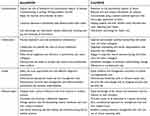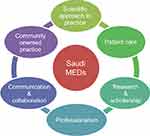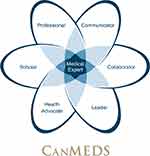Back to Journals » Advances in Medical Education and Practice » Volume 10
SaudiMEDs and CanMEDs frameworks: similarities and differences
Authors Shadid AM , Bin Abdulrahman AK , Bin Dahmash A , Aldayel AY , Alharbi MM, Alghamdi A , Alasmari A, Qabha HM , Almadi M , Almasri M , Aloyouny S, Alotaibi Y, Almotairy Y, Bukhari YR , Bin Abdulrahman KA
Received 22 October 2018
Accepted for publication 15 April 2019
Published 6 May 2019 Volume 2019:10 Pages 273—278
DOI https://doi.org/10.2147/AMEP.S191705
Checked for plagiarism Yes
Review by Single anonymous peer review
Peer reviewer comments 3
Editor who approved publication: Dr Md Anwarul Azim Majumder
Asem M Shadid, Amro K Bin Abdulrahman, Abdulmajeed Bin Dahmash, Abdulrahman Yousef Aldayel, Muteb Mousa Alharbi, Abdullah Alghamdi, Abdulaziz Alasmari, Hamad M Qabha, Mansour Almadi, Mohammed Almasri, Saleh Aloyouny, Yasir Alotaibi, Yazeed Almotairy, Yousef R Bukhari, Khalid A Bin Abdulrahman
Department of Medical Education, College of Medicine, Imam Mohammad Ibn Saud Islamic University (IMSIU), Riyadh, Saudi Arabia
Background: The SaudiMEDs framework was founded and adopted by the Saudi Deans’ Committee in 2011 to ensure that Saudi medical graduates learned core competencies. Meanwhile, CanMEDs was established by the Canadian Royal College of Physicians and Surgeons in 1996 and aimed to establish the abilities and skills of all aspects of medical practice, as well as to ensure the acquisition of basic knowledge related to medical education. The main purpose of this study was to explore the similarities and differences between both frameworks.
Methods: In March and April 2017, 15 researchers conducted an extensive review of both the SaudiMEDs and CanMEDs frameworks using a semi-quantitative evaluation with color codes to determine the following: the exact similarities in both frameworks, the close similarities, and the unique differences.
Results: According to the coloring system, most of the frameworks were similar. For example, Leadership, Communication and Professionalism were almost identical in both frameworks. There was some degree of similarity between both frameworks in “Collaborator”. Furthermore, the SaudiMEDs framework had a unique input which involved the most essential skills that undergraduate medical students must acquire.
Conclusion: SaudiMEDs has great potential to improve the quality of Saudi medical graduates in a manner that fits our current and future needs. CanMEDs focuses mainly on outcomes and processes, while SaudiMEDs focuses more on outcomes. SaudiMEDs was not created to provide a copy-and-paste curriculum. The ultimate goal was to create an outcome-based curriculum that ensures the quality of Saudi medical school graduates.
Keywords: SaudiMEDs, CanMEDs, framework, competency-based education, Saudi Arabia
Introduction
In Saudi Arabia, there has been a simultaneous increase in interest in medical education and a rapid expansion in the number of medical schools.1–5
Saudi medical schools have developed their curricula so that they match the most-recognized medical education trends worldwide. Currently, Saudi Arabia has 28 public and 9 private medical schools.6 All medical schools in Saudi Arabia offer five-year programs preceded by a one-year preparatory program and followed by one year of an internship. Most Saudi medical schools accept high school entries through a highly competitive admissions system. Most Saudi undergraduate medical curricula provide an education that is problem-based, integrated, community-oriented and competency-based.
On the other hand, Canada has 17 medical universities offering medical programs in English and French. The medical program in Canada is three to five years long depending on the university and the background of each student. In the five-year medical study program in Canada, the first year is a preparatory year designed for those students who do not have a bachelor’s degree in an appropriate science. To enter the four-year medical program, the student must have a bachelor’s degree in biology or another appropriate field.7
The Saudi Med initiative was started as an effort to develop national consensus amongst Saudi stakeholders in terms of the vision of the “Saudi Future Physician” and to develop the essential learning outcomes for medical schools. It was conducted between 2005 and 2007.8 It aimed to provide methods of ensuring minimum standards in undergraduate medical education. As a result, the Saudi Medical Deans’ Committee founded an initiative to establish common core learning outcomes (LOs)/competencies for medical degree programs in Saudi Arabia. Its aim was to harmonize the Saudi Medical Higher Education Sector. Beginning in 2009, the designated committee for Phase I started its task, which was completed by 2011. The product was published as SaudiMEDs: A competence specification for the Saudi medical graduates, Medical Teacher.8 The Saudi Medical Deans’ Committee started Phase II in September 2012 to describe a set of learning outcomes for the primary medical degree in Saudi Arabia. The outcomes were generated through an extensive process of expert development and review. It also considered the previous work on LOs in medicine. These outcomes were distributed to all Saudi medical colleges for revision and comments. The feedback was analyzed using the Delphi Technique19 to approve the first draft. This draft was discussed during two workshops attended by the most important stakeholders with respect to the graduates of Saudi medical colleges. In addition to providing comments during the workshop, the participants responded to an individual survey, whose results were incorporated into the responses of other stakeholders not invited to the workshop. Opinions and comments were considered for a further detailed analysis.10
CanMEDs was established by the Royal College in 1996 and updated in 2005. It is now globally accepted and a universally adapted framework of competencies for medicine or other health-related professions. CanMEDs aims to establish the abilities and skills of all aspects of medical practice and to ensure basic knowledge in medical education. In addition, hundreds of participants and many organizations inside and outside Canada were involved in the establishment of the 2015 edition of the CanMEDs framework as a third edition.11 The CanMEDs competency framework has been utilized outside Canada.12 Recently, it was adopted for use in a dental specialty program.13
Before the foundation of the Saudi Commission for Health Specialties in 1995, most Saudi medical graduates pursued their postgraduate residency training in Canadian residency programs under the supervision of the Canadian Royal College of Physicians and Surgeons. Most Saudi medical trainees in Canada perceived the educational aspects of their training as a positive experience.14 In 2018, more than 1000 Saudi medical residents were trained in Canada.15 This paper aims to explore whether SaudiMEDs has major or minor differences compared to CanMEDs as a national competency-based framework.
Material and methods
An extensive review of both SaudiMEDS and CanMEDS frameworks was done by 15 researchers from March to June 2017. One of the co-authors is a professor of medical education, whereas the rest of the researchers are assistant researchers in medical education.
Both frameworks were thoroughly read and compared using a semi-quantitative evaluation with color codes designed to determine the following: the exact similarity in both frameworks, the close similarities and the unique differences. The review was conducted in three phases: first, a complete reading and full understanding of both frameworks including their histories, aims and classifications; second, a comparison of the two frameworks in terms of themes and subthemes using the assigned coloring codes (yellow for identical similarities, blue for similar concepts but different writing styles, green for similar ideas but written in differently or placed in a different category, and red for aspects that were uniquely written in just one of the frameworks (Table 1)); third, a final revision and writing up of the consensus report. In addition, expert opinions were sought from the founders of the SaudiMEDS framework through a semi-structured interview in May 2017.
 | Table 1 The assigned coloring system used to compare both frameworks |
Results
According to the coloring codes, most aspects of the frameworks were similar (Table 2). However, differences between SaudiMEDS and CanMEDS were documented. The first differences were in terms of the numbers and names of the main competencies. For instance, SaudiMEDS comprises six main themes, as shown in Figure 1 (Scientific Approach to Practice, Patient Care, Community Oriented Practice, Communication and Collaboration, Professionalism, and Research and Scholarship). On the other hand, CanMEDS comprises seven main competencies (Medical Expert, Communicator, Collaborator, Leader, Health Advocate, Scholar, and Professional) (Figure 2). Table 3 summarizes the similar concepts in both frameworks but with different wording. The major differences between CanMEDS and SaudiMEDS are described in Table 4.
 | Table 2 Similarity between SaudiMEDS and CanMEDS frameworks with same wording in all competencies |
 | Table 3 Similar concepts in both frameworks but with different wording |
 | Table 4 Major differences between CanMEDS and SaudiMEDS |
 | Figure 1 The Six Main Themes in SaudiMEDS. SaudiMEDs framework 2016: Saudi medical education directives framework. In press. |
Leadership was considered a main competency in CanMEDS and was mentioned as an intrinsic role in the Medical Expert competency. However, in SaudiMEDS, leadership was under the Professionalism competency, not as a separate entity. In addition, it was less prominent and less detailed as compared to CanMEDS.
In Medical Expert, both frameworks were similar in terms of establishing patient-centered care. In SaudiMEDS, this is called Patient Care and Scientific Approach to Practice, in two different themes. Scientific Approach to Practice includes knowing and explaining the normal structure, biochemical basis, human life cycles (pregnancy, birth, growth and aging), pathology of diseases, pharmacological basis and role and impact of nutrition. In addition, it includes managing common medical emergencies, acknowledging the principles of spiritual and prophetic medicine and recognizing the principles and roles of complementary and alternative medicine.
Discussion
To our knowledge, this is the first study comparing the SaudiMEDs and CanMEDs frameworks. The current study has documented several similarities between the two frameworks. For example, Communicator is very similar in both frameworks. Other similarities are, specifically, appropriate documentation, attention to the psychosocial aspects of illness, breaking bad news, effective oral and written information for patient care across different media, ethics in the physician-patient encounter, privacy and confidentiality, and communicating using a patient-centered approach that encourages patient trust and autonomy.
The term “collaborator” means physicians’ ability to work in a team, sharing decisions and resolving conflicts.16 There was some degree of similarity between the SaudiMEDs and CanMEDs frameworks in that matter. The aim of CanMEDs was to provide safe, high-quality and patient-centered care.
Professionalism was considered one of the main competencies in both frameworks. Meanwhile, in SaudiMEDs, this category contained an Islamic professionalism competency, which includes applying the Islamic law (Fiqh) in health-related practice.17 Also, SaudiMEDs stated that the leader should be professional in managing people with complaints, criticisms, conflicts and change.
Although CanMEDs discussed core competencies for medical graduates, the SaudiMEDs framework had a unique input which involved the most essential skills that undergraduate medical students must acquire. Furthermore, some competencies were a bit exaggerated in terms of the necessity that medical graduates acquire them. One example is leadership skills. Leadership is a skill that not everyone has; otherwise, it would cause problems. For example, not all medical graduates can lead a medical team or lead a research project or even lead their classmates, as leadership was a key skill that a majority of students were lacking in group projects.18
Also, the SaudiMEDs framework had a more positive emphasis on knowing how to deal with common medical issues and diseases in practice, as it encourages future medical doctors to acquire knowledge of common local illnesses and how to approach them. In addition, SaudiMEDs required future medical doctors to have sufficient knowledge of complementary and alternative medicine – a very important topic in Saudi society, which has unfortunately seen inappropriate practices.19 Therefore, medical graduates should be aware of these practices so that they can advise patients to adhere to proper practices, which are evidence-based in complementary and alternative medicine.
Moreover, there were detailed competencies that it “goes without saying” that medical experts in CanMEDs should have. For example, a medical doctor should maintain a complete approach, from obtaining consent, taking the patient’s history and performing physical examinations to creating a plan of management with the patient and his or her family.20,21
Furthermore, CanMEDS maintained an excellent competence regarding the area of “scholar” which stressed that the medical graduate should be a critical thinker in all aspects of medical practice and ensure a safe learning environment, as well as address medical dilemmas and knowledge gaps with a scientific and professional methodology. Also, SaudiMEDS addressed some of these points in its framework.
Conclusion
Our study concludes that there were remarkable similarities between the two frameworks, as they have a great influence on communication skills and teamwork in medical practice. Apart from that, the CanMEDS framework focused more on medical details and processes while SaudiMEDS had a considerably more general approach towards medical outcomes. The SaudiMEDS framework has great potential to improve the quality of Saudi medical graduates to meet our current and future needs. Finally, additional studies using quantitative measurement may be needed to examine the impact of both frameworks.
Disclosure
The authors report no conflicts of interest in this work.
References
1. Bin Abdulrahman KA, Harden RM, Patricio M. Medical education in Saudi Arabia: an exciting journey. Med Teach. 2012;34:S4–S5. doi:10.3109/0142159X.2012.660509
2. Al-Sulaiman AA. Saudi medical education: challenges in the new millennium. J Family Community Med. 2000;7(1):15–20.
3. Al-Gindan YM, Al-Sulaiman AA, Al-Faraidy A. Undergraduate curriculum reform in Saudi medical schools. Which direction to go? Saudi Med J. 2000;21(4):324–326.
4. Telmesani A, Zaini RG, Ghazi HO. Medical education in Saudi Arabia: a review of recent developments and future challenges. East Mediterr Health J. 2011;17(8):703–707.
5. Shawky S, Soliman NK. Going beyond the curriculum to promote medical education and practice in Saudi Arabia. Saudi Med J. 2001;22(6):477–480.
6.
7.
8. Zaini R, Bin Abdulrahman K, Al-Khotani A, Al-Hayani A, Al-Alwan I, Jastaniah S. Saudi meds: a competence specification for Saudi medical graduates. Med Teach. 2011;33(7):582–584. doi:10.3109/0142159x.2011.578180
9. Reid NG. The Delphi technique, its contributions to the evaluation of professional practice. In: Ellis R, editor. Professional Competence and Quality Assurance in the Caring Professional. Beckenham: Croom Helm; 1988:230–262.
10. Al-Rukban MO, Al-Hayani AA, Al-Rumayyan A, et al. SaudiMEDs Framework: (Saudi Medical Education Directives Framework); In press. 2016.
11. Jr F, Snell L, Sherbino J, editors. CanMEDS 2015 Physician Competency Framework. Ottawa: Royal College of Physicians and Surgeons of Canada; 2015.
12. Jilg S, Möltner A, Berberat P, et al. How do supervising clinicians of a University Hospital and associated teaching hospitals rate the relevance of the key competencies within the CanMEDS roles framework in respect to Teaching in clinical clerkships? GMS Z Med Ausbild. 2015;32(3):Doc33.
13. Al Askar B, Al Sweleh F, Al Wasill E, Amin Z. Restructuring Saudi Board in restorative dentistry (SBRD) curriculum using CanMEDS competency. Med Teach. 2018;1–7.
14. Assiri A, Al-Jarallah A, Al-Amari O, Turnbull J. Perception of Canadian training programs by Saudi resident trainees. Ann Saudi Med. 2002;22(5–6):320–323. doi:10.5144/0256-4947.2002.320
15. Vogel L. Saudi medical trainees may keep posts in Canada. CMAJ. 2018;190(37):E1120. doi:10.1503/cmaj.109-5659
16. O’Daniel M, Rosenstein AH. Professional communication and team collaboration. In: Hughes RG, editor. Patient Safety and Quality: An Evidence-Based Handbook for Nurses. Rockville (MD): Agency for Healthcare Research and Quality (US); 2008 Apr. Chapter 33. Available from:
17. Bin Abdulrahman KA. The current status of medical education in the Gulf cooperation council countries. Ann Saudi Med. 2008;28(2):83–88.
18. Benefits HR. Problems with student teams: suggestions for improving team projects. J Educ Bus. 2006;82(1):11–19. doi:10.3200/JOEB.82.1.11-19
19. Alrowais N, Alyousefi N. The prevalence extent of Complementary and alternative medicine (CAM) use among Saudis. Saudi Pharm J. 2017;25(3):306–318. doi:10.1016/j.jsps.2016.09.009
20. Kassirer J, Wong J, Kopelman R. Learning Clinical Reasoning.
21. Lown B. The Lost Art of Healing: Practicing Compassion in Medicine.
 © 2019 The Author(s). This work is published and licensed by Dove Medical Press Limited. The full terms of this license are available at https://www.dovepress.com/terms.php and incorporate the Creative Commons Attribution - Non Commercial (unported, v3.0) License.
By accessing the work you hereby accept the Terms. Non-commercial uses of the work are permitted without any further permission from Dove Medical Press Limited, provided the work is properly attributed. For permission for commercial use of this work, please see paragraphs 4.2 and 5 of our Terms.
© 2019 The Author(s). This work is published and licensed by Dove Medical Press Limited. The full terms of this license are available at https://www.dovepress.com/terms.php and incorporate the Creative Commons Attribution - Non Commercial (unported, v3.0) License.
By accessing the work you hereby accept the Terms. Non-commercial uses of the work are permitted without any further permission from Dove Medical Press Limited, provided the work is properly attributed. For permission for commercial use of this work, please see paragraphs 4.2 and 5 of our Terms.

